#odysseus lander
Text



#this is why we should nationalize these companies#space#science#lunar lander#the moon#odysseus lander
13K notes
·
View notes
Text

here's how we can still win Odysseus-bros...
#spaceflight director sana#sana tsukumo#hololive#odysseus lander#im-1#geostationary#subscribe for more Expert Spaceflight Analysis!#comic#wlart#williamleonard
394 notes
·
View notes
Text
Hey guess what? Nobody's on the moon
#odysseus#Odysseus lander#lunar lander#its a dumb joke#but its my joke#unless someone else made it first#then its our joke
196 notes
·
View notes
Text
I'm still not over the Odysseus moon lander, and I don't think I ever will.
I've always had a varying interest in space for as long as I can remember, and Greek Mythology has always had a special place in my heart. With both colliding in such a unique way, it tickles me pink.
But why did it have to be like this...
Odysseus is one of my favorite characters from the myths. The Odyssey brings me to tears every time I read it. It's a beautiful story of determination to return home again despite the possibility of rejection and how much has changed. It means so much to me that this story has gotten so much recognition in recent years, but why like this?
Why this lander? Why this lander when its only fate is to fizzle out and be forgotten? Why this lander that was sent away forever? Why this lander that will never return to its creators or home?
Why this lander that will die cold and alone?
From the interviews and reporting I've seen, the engineers and scientists were fond of the lander. They talk about it with affection. They gave it a nickname.
"Odie"
So I wonder... Did they know?
Did they know what that name means? The name Autolychus gave to that squirming babe in his arms. His grandson. The name of the king who would achieve feats that will be sung for centuries, millennia. The name of the man whose return would be synonymous with a long journey.
Do they know they named this first return to the moon in 50 years "hatred"? And do they realize that by leaving the lander to die, they fulfill the true meaning of that name?
#char ramblings#odysseus#odysseus lander#space#nasa#moon landing#artemis mission#char writes#why am i sobbing over a really expensive hunk of metal and circuits? ;-;
28 notes
·
View notes
Text
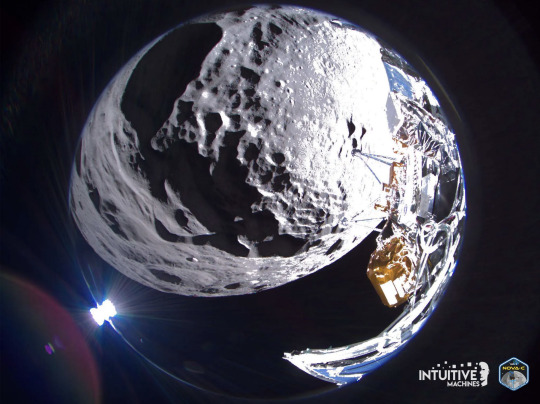
The first photo the Odysseus Lander has sent back from the surface of the moon today. Unfortunately, the Odysseus "tripped" on a rock at touchdown and is now laying on its side. So, I guess turn your head ninety degrees and look at the photo. 😂
21 notes
·
View notes
Text
This video broke me completely.
https://youtu.be/fH1kBZkrQ80?si=lL6eLXcQlpJdrsAR
#what the fuck do you mean “it lost its navigation system”#also “it's not returning” (or something like that) LIKE SIR#i'm not ok#odysseus#odysseus lander#iro and their tedtalks
4 notes
·
View notes
Text
Guys. There was a conceptual design for a lunar (or martian?) landing mechanism that involved a bunch of big pads being inflated around the module, such that when it landed, it would spread out the impact by bouncing around for a while before finally settling, at which point it would deflate itself. There was a gif associated with it, too. I need to find this, and all of my efforts so far have been in vain. I'm having a conversation about both the Odysseus lander and Weebles, and this is the crucial link between the two.
#lander#lunar lander#nasa#martian lander#Odysseus Lunar Lander#odysseus lander#space lander#moon mission#space#idk what other tag spam to put on this
0 notes
Text
#intuitive machines#moon landing#moon lander#space#space exploration#news#space news#the moon#moon#odysseus lander
0 notes
Text
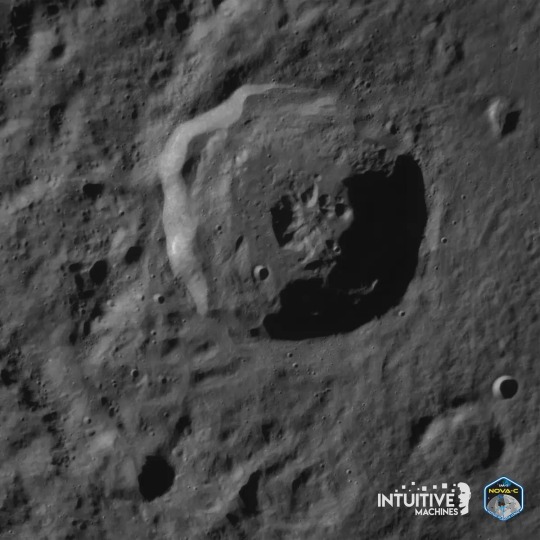
(Picture Odysseus took of the Bel’kovich K crater from orbit)
Yesterday (2/22) at around 5:24 Central Time, Odysseus landed on the moon. This is the first US spacecraft to land on the moon in over 50 years.
It is a privately-built spacecraft from Intuitive Machines, but it got a lot of its funding from NASA, which has several scientific instruments aboard that it wants delivered to the moon.
Odysseus had a huge scare, where it lost communications for a far longer period of time than expected (it was supposed to stop sending telemetry data shortly before its landing, but it did not quickly regain contact after landing). Nevertheless, it has been confirmed that Odysseus landed on the moon upright in one piece and is sending a signal. Last I checked, they’re working on downloading images from the moon’s surface, but it’s unclear if the lander will be able to fulfill its complete mission objectives.
While Odysseus’s journey took a total of a week, rather than the 10 years of its mythological counterpart, it still had quite the Odyssey. Its path included multiple orbit corrections, timing changes, and navigation issues that forced it to rely on NASA’s experimental LIDAR rather than its actual intended equipment.
Private space travel is an experiment in of in itself, and I’ll admit I’m kind of skeptical about it. Odysseus ran into a lot of problems, but it may be possible that it will still succeed. While the unexpected issues with Odysseus don’t inspire confidence, stuff like this is common in space travel. I think Odysseus—and perhaps even the future of private spacecraft—will be judged by their end result. So I’m holding out hope for those moon surface pictures.
1 note
·
View note
Text
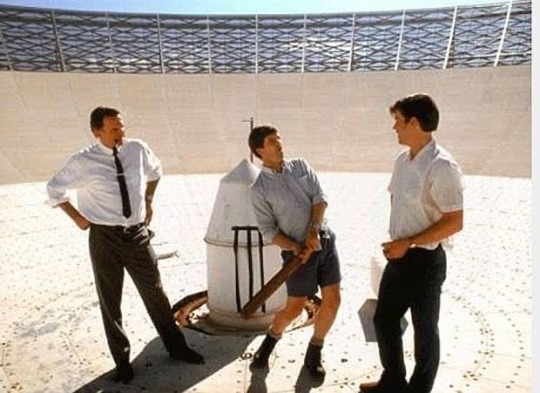


And tonights telemetry will be brought to you by ‘The Dish’. The same ‘Dish’ that brought you the Apollo 11 landing.
You know. The fake moon landing broadcast from the fake Australia?
I try not to be acerbic but I find I cannot help it and I don’t wish to.
#science#space exploration#moon mission#odysseus lander#tracking stations#parkes radio telescope#the dish#parkes#new south wales#australia#checkmate conspiracy nutjobs
1 note
·
View note
Text
damn Odysseus really isnt back at Ithaca? he pissed off so many gods they put him on the moon? poor Penelope and Telemachus
355 notes
·
View notes
Text
the fact that tumblr is crying over a spaceship just because it's named for some greek dude cracks me up
38 notes
·
View notes
Text
20 notes
·
View notes
Text


The United States has returned to the lunar surface for the first time in more than 50 years after a privately-built spacecraft named Odysseus capped a nail-biting 73-minute descent from orbit with a touchdown near the moon’s south pole.
Amid celebrations of what NASA hailed “a giant leap forward,” there was no immediate confirmation of the status or condition of the lander, other than it had reached its planned landing site at crater Malapert A.
But later Intuitive Machines, the Texas-based company that built the first commercial craft to land on the moon, said the craft was “upright and starting to send data.”
The statement on X said mission managers were “working to downlink the first images from the lunar surface.”
The so-called “soft landing” on Thursday, which Steve Altemus, the company’s founder, had given only an 80% chance of succeeding, was designed to open a new era of lunar exploration as NASA works towards a scheduled late-2026 mission to send humans back there.
“Welcome to the moon,” Altemus said when touchdown when the 5.23pm touchdown was eventually confirmed, after about 10 minutes in which Odysseus was out of contact.
It was the first time any US-built spacecraft had landed on the moon since NASA’s most recent crewed visit, the Apollo 17 mission in December 1972, and the first visit by commercial vehicle following last month’s failure of Peregrine One, another partnership between the space agency and a private company, Astrobotic.

“Today, for the first time in more than a half century, the US has returned to the moon. Today, for the first time in the history of humanity, a commercial company, an American company, launched and led the voyage up there,” Bill Nelson, the NASA administrator, said.
“What a triumph. Odysseus has taken the moon. This feat is a giant leap forward for all of humanity.”
There was no video of Odysseus’s fully autonomous descent, which slowed to about 2.2mph at 33ft above the surface.
But a camera built by students at Florida’s Embry-Riddle Aeronautical University was designed to fall and take pictures immediately before touchdown, and NASA cameras were set to photograph the ground from the spacecraft.
The 14ft (4.3 metres) hexagonal, six-legged Nova-C lander, affectionately nicknamed Odie by Intuitive Machines employees, is part of NASA’s commercial lunar payload services (CLPS) initiative in which the agency awards contracts to private partners, largely to support the Artemis program.
NASA contributed $118m to get it off the ground, with Intuitive Machines funding a further $130m ahead of its February 15 launch from Florida’s Kennedy Space Center on a Falcon 9 rocket from Elon Musk’s SpaceX company.

The IM-1 mission, like the doomed Peregrine effort, is carrying a payload of scientific equipment designed to gather data about the lunar environment, specifically in the rocky region chosen as the landing site for NASA’s crewed Artemis III mission planned for two years’ time.
It is a hazardous area – “pockmarked with all of these craters,” according to Nelson – but chosen because it is believed to be rich in frozen water that could help sustain a permanent lunar base crucial to future human missions to Mars.
Scientists announced last year that they believed tiny glass beads strewn across the moon’s surface contained potentially “billions of tonnes of water” that could be extracted and used on future missions.
The risks are worth it, Nelson told CNN on Thursday, “to see if there is water in abundance. Because if there’s water, there’s rocket fuel: hydrogen, and oxygen. And we could have a gas station on the south pole of the moon.”
The planned operational life of the solar powered lander is only seven days, before the landing site about 186 miles from the moon’s south pole moves into Earth’s shadow.
But NASA hopes that will be long enough for analysis of how soil there reacted to the impact of the landing.
Other instruments will focus on space weather effects on the lunar surface, while a network of markers for communication and navigation will be deployed.
“Odysseus, powered by a company called Intuitive Machines, launched upon a SpaceX rocket, carrying a bounty of NASA scientific instruments, is bearing the dream of a new adventure in science, innovation, and American leadership in space,” Nelson said.


Through Artemis, NASA’s return-to-the-moon program that also has longer-term visions of crewed missions to Mars within the next two decades, the US seeks to stay ahead of Russia and China, both of which are planning their own human lunar landings.
Only the US has previously landed astronauts in six Apollo missions between 1969 and 1972, while five countries have placed uncrewed spacecraft there.
Japan joined the US, Russia, China, and India last month when its Smart Lander for Investigating the Moon (Slim) made a successful, if awkward touchdown after a three-month flight.
Two further Intuitive Machines launches are scheduled for later this year, including an ice drill to extract ingredients for rocket fuel, and another Nova-C lander containing a small Nasa rover and four small robots that will explore surface conditions.
https://www.theguardian.com/science/2024/feb/22/us-moon-landing-odysseus-intuitive-machines
youtube
US returns to lunar surface with for first time in over 50 years
23 February 2024
A spacecraft built and flown by Texas-based company Intuitive Machines landed near the south pole of the moon, the first US touchdown on the lunar surface in more than half a century, and the first ever achieved entirely by the private sector.
Communication with Odysseus seemed be lost during the final stages of the landing, leaving mission control uncertain as to the precise condition and position of the lander, according to flight controllers heard in the webcast.
US returns to lunar surface for first time in over 50 years: ‘Welcome to the moon.’
#Odysseus#Intuitive Machines#Youtube#NASA#Malapert A#moon#moon landing#spacecraft#Steve Altemus#lunar exploration#Bill Nelson#Nova-C lander#Odie#commercial lunar payload services (CLPS)#Artemis#Kennedy Space Center#Falcon 9#Elon Musk#SpaceX#IM-1 mission#Smart Lander for Investigating the Moon (SLIM)#lunar lander#earth
22 notes
·
View notes
Photo
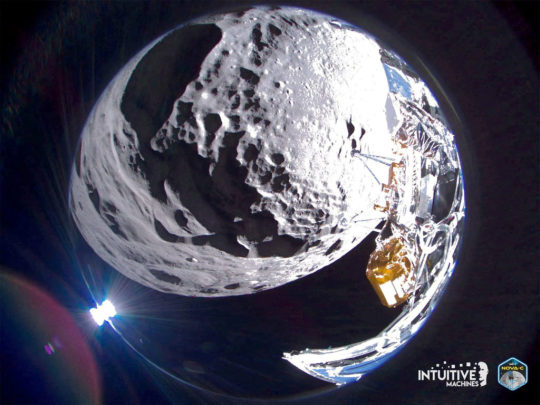
With only hours until it dies, lunar lander Odysseus sends back more photos of the moon | PBS NewsHour
19 notes
·
View notes
Text
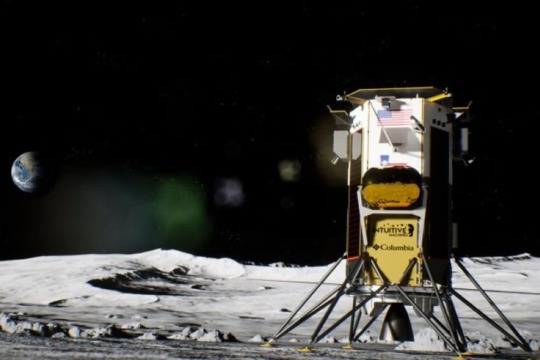
Yeah yeah, all very impressive—but let’s see it get back…
13 notes
·
View notes